2024 Yoga Mats Buying Guide - Learn What Yoga Mat Is The Best
The yoga mat is one of the necessary tools to practice yoga. When you choose to buy a yoga mat, there are several factors to consider. Here is a detailed guide to buying a yoga mat. We'll go over the material, thickness, size, and slip resistance of yoga mats to help you understand which type of yoga mat is best.
The yoga mat is one of the necessary tools to practice yoga. When you choose to buy a yoga mat, there are several factors to consider. Here is a detailed guide to buying a yoga mat. We'll go over the material, thickness, size, and slip resistance of yoga mats to help you understand which type of yoga mat is best.
Table of contents
â— UNDERSTANDING SNOWBOARD OUTERWEAR
â—‹ The materials of yoga mat
â—‹ Common thickness of yoga mat
â—‹ Common sizes of yoga mats
â—‹ The slip resistance of yoga mat
â—‹ Yoga mat color and pattern
â— Maintenance of yoga mat
â—‹ Yoga mat cleaning method
â—‹ Tips for increasing the slip resistance of yoga mats
â— Conclusion of yoga mat purchase guide
â— Who we are & our services
Yoga Mat Selection Guide
The Materials of Yoga Mat
PU (leather) :
Yoga mats made of leather are known for their high anti-slip ability. For advanced yogis or those who regularly practice difficult yoga, yoga mats made of PU material can be preferred. In addition, leather is not easy to wear, and can easily wipe the dirt. Unfortunately, leather material is heavy, more suitable for indoor sports, and usually not easy to carry out.

Advantages: anti-skid high, easy to clean and wipe, not easy to wear
Disadvantages: heavy weight, inconvenient to carry
Cork:
Cork is a natural and environmentally friendly material, with very good elastic memory, high durability, and a light natural smell, and it will not feel cold when used in winter. However, as a natural material, the price is higher than other materials, and the material characteristics make it difficult to clean the yoga mat.
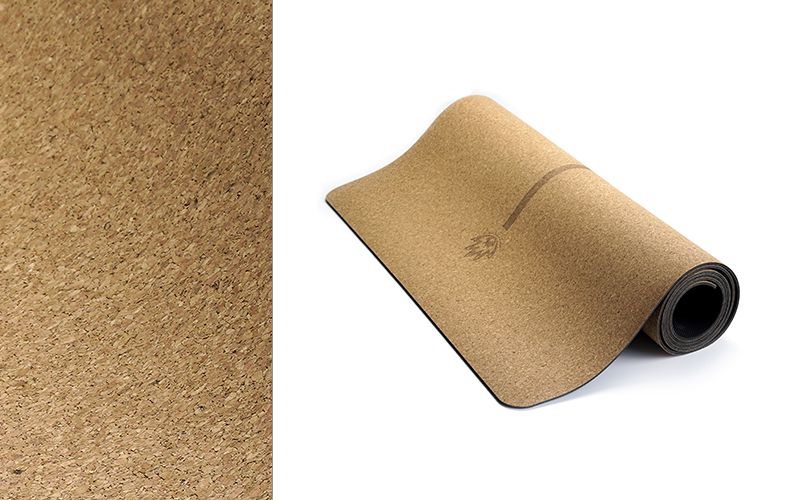
Advantages: natural environmental protection material, safe and flexible, suitable for children
Disadvantages: high price, difficult to clean
Linen:
As a natural material, linen is environmentally friendly and non-toxic. It has a faint woody scent. Due to the characteristics of linen, it has excellent anti-slip properties and can be used for various yoga postures. However, because the surface material is easy to hide dirt, is not easy to clean, and is easy to get wet and hard to dry, it will often leave indentations on the body during yoga exercises and cause discomfort. People with sensitive and fragile skin should choose carefully. It is recommended to lay down a yoga towel or cushion when stretching.
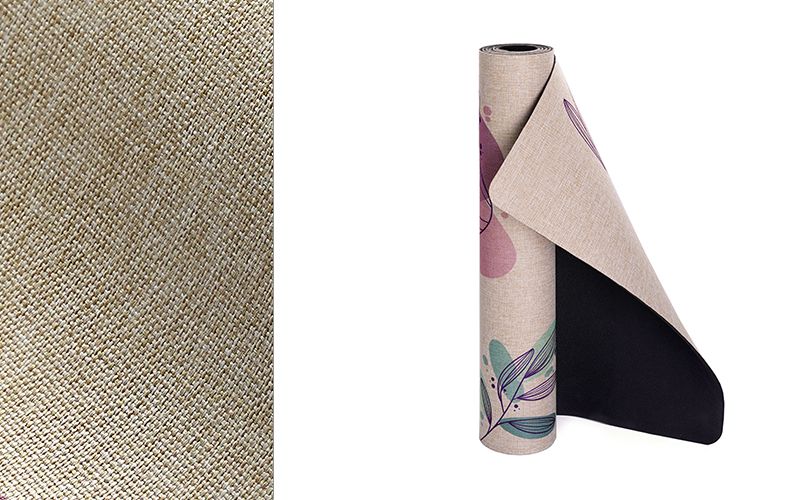
Advantages: high anti-skid force, natural environmental protection material, no pungent smell
Disadvantages: It is not easy to clean, easy to get wet, and those with sensitive skin should choose carefully
Natural Rubber:
Yoga mats made of natural rubber are the most popular among yoga practitioners who value environmental protection, love natural products, and value health. Its durability and stability are better and its grip is quite good, but due to its certain weight, it is more suitable for indoor use and not conducive to portability. In addition, natural rubber itself has an odor. It is for people who resist this smell or are allergic to latex. When using it for the first time for people who resist this smell or are allergic to latex, use baking soda to add water, or wipe the yoga mat with apple cider vinegar and then dry it thoroughly, the rubber smell will be reduced.
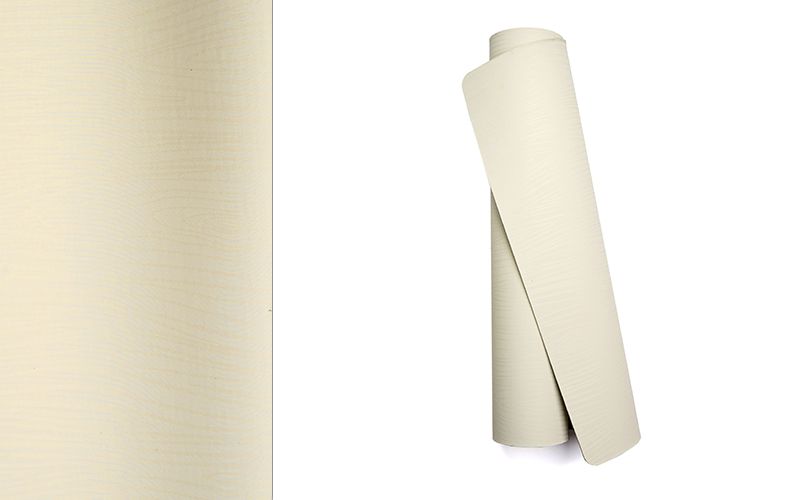
Advantages: environmental protection material, high stability, high durability
Disadvantages: expensive, heavy, not suitable for people with latex allergies
TPE (Thermoplastic elastomer, thermoplastic elastic material) and EVA
TPE is a non-toxic and environmentally friendly material, which can be recycled and reused. It has no pungent smell, good waterproof performance, light weight and easy to carry. The advantages of these two materials, TPE and EVA, are that they are easy to wash with water, and because of their low density and light weight, they are suitable for carrying when going out. Good cushioning performance, even if the thickness is thin, it can provide a certain degree of protection. The anti-slip performance is poor, and it is more suitable for static elementary yoga training, not suitable for high-difficulty yoga training.
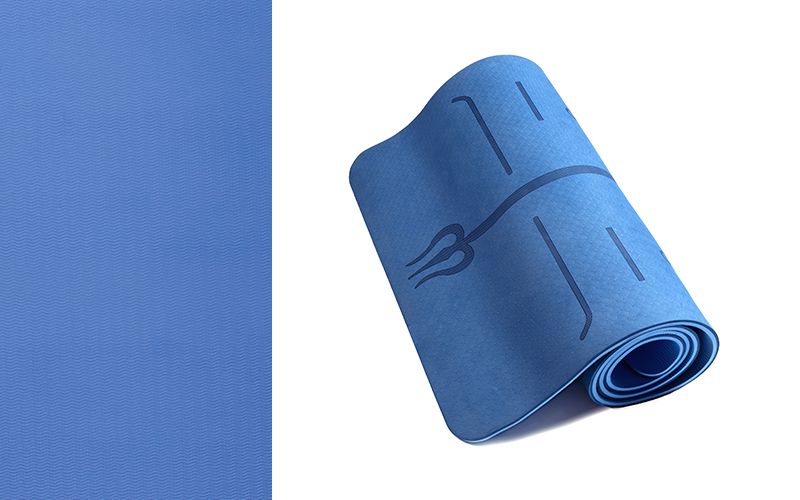
Advantages: waterproof, environmentally friendly and non-toxic, no pungent odor, convenient and portable, good cushioning performance
Disadvantages: weak anti-slip, not suitable for intense yoga
The material of the yoga mat will directly affect its quality and service life. In addition, PU, cork, linen, suede, and other materials are usually compounded with rubber and TPE materials. When choosing a yoga mat, we must choose a yoga mat that suits us, not just a high price.
Common Thickness of Yoga Mat
At present, the thickness of yoga mats on the market is usually between 3 and 8mm. Yoga mats of different thicknesses are suitable for different environments and exercise intensities. You can choose the appropriate thickness of yoga mats according to your own exercise needs.
1~3mm yoga mat: suitable for those yoga enthusiasts who like to practice close to the ground and pay attention to the strength and stability of connecting to the ground.
4~5mm yoga mat: suitable for yoga practice with light exercise, and moderate exercise that needs better cushioning and protection of joints.
6~8mm yoga mat: suitable for high-intensity exercise that requires more cushioning and support.
Yoga mat thickness customization: If you have special needs, please contact us to customize yoga mats of different thicknesses.
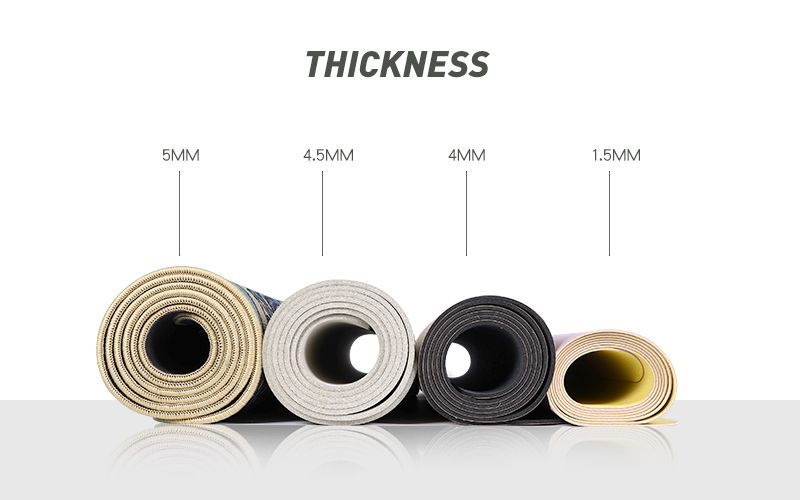
Yoga mat thickness for beginners, intermediate and advanced yogis
Beginner yogis: It is recommended to choose more than 6mm to relieve the discomfort of the support point and give more protection to the body.
Intermediate yogis: 4-5mm medium thickness can be used, suitable for various yoga positions, and most people will choose it.
Advanced yogis: The postures practised are relatively difficult. In order to improve stability, it is recommended to choose a thin yoga mat under 3mm.
It should be noted that the thickness of the yoga mat is only one aspect when choosing yoga mats. To choose a suitable yoga mat, multiple factors should be considered such as personal situation, type of yoga practice, and ground hardness. When choosing a yoga mat, you can choose the appropriate thickness according to personal needs and experience.
Common Sizes of Yoga Mats
1. Standard model: 61cmx173cm. This type of yoga mat is suitable for practitioners with a height of 158-170 cm.
2. Extended version: 61cmx183cm. This type of yoga mat is suitable for practitioners with a height of 170 cm or more.
3. Customized models: In addition to regular sizes, we can customize other sizes or special shapes according to your requirements.

The standard specification for a yoga mat is usually 68 inches (173 cm) long and 24 inches (61 cm) wide. The standard-size yoga mat is suitable for most people. If you need more space, then you can choose a wide model yoga mat, which is usually 5-10 inches (12.7-25.4 cm) wider than a standard-sized yoga mat. You can choose according to your personal body type. Basically, you only need to pay attention to the length of the yoga mat when lying flat. The length of the yoga mat should exceed your height, and the width is recommended to be wider than your shoulders. If you need to take a yoga mat with you, a travel yoga mat may be more suitable for you, and it is usually lighter than a standard-sized yoga mat and can be foldable or rollable.
The Slip Resistance of Yoga Mat
The slip resistance of yoga mats is very important for the safety and stability for yoga practice. Some yoga practices require stable support, and a slippery yoga mat can affect the body's posture and balance. The slip resistance of yoga mats usually depends on factors such as material, surface treatment and application environment. The following are some yoga mat materials with better anti-slip properties:
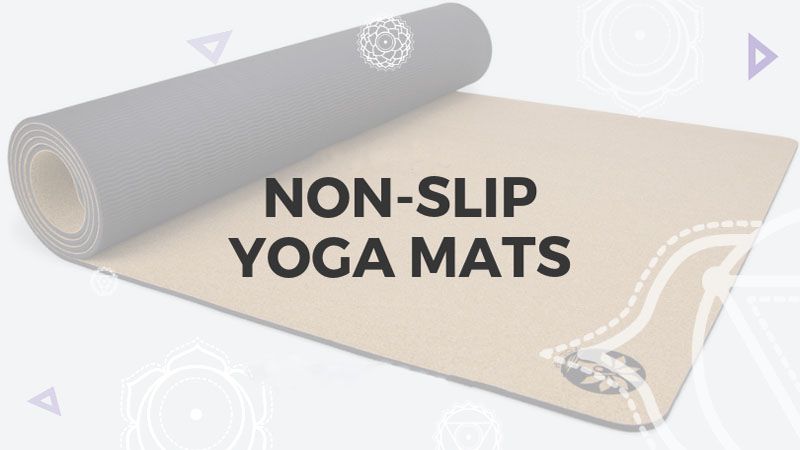
Natural rubber: The natural rubber yoga mat has a certain degree of stickiness, so it will be better fixed on the ground without slipping.
TPE material: TPE material is an environmentally friendly material, which is often used to make non-slip yoga mats. Its surface is soft and more slip-resistant.
PU material: PU yoga mats have good slip resistance and durability, but are usually heavier than other yoga mats. Textured surfaces provide a better anti-slip effect.
Flax material: The hemp yoga mat also has good anti-slip performance due to its own characteristics.
Generally speaking, the yoga mats of the above four materials all have the best anti-slip properties, but different brands&models of yoga mats will also vary due to different material quality and surface treatment. When purchasing a yoga mat, you can choose a suitable non-slip yoga mat according to your needs and budget.
Yoga Mat Color And Pattern
The choice of color and pattern for a yoga mat varies from person to person, but in general, it's a subjective choice. Studies have shown that different colors or patterns of yoga mats may have an impact on people's emotional and psychological states:
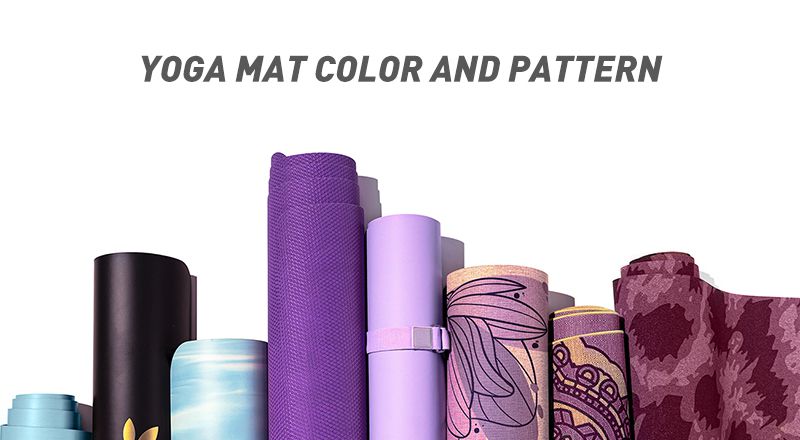
Basic Colors: Basic colors like black, blue, grey, purple and pink are some of the most common choices. These colors are relatively low-key, suitable for users who don't like to behave flamboyantly.
Bright colors: If you like bright colors, you can choose bright red, orange or yellow, etc. These colors can bring vitality and excitement to people.
Floral Patterns: Floral patterns on yoga mats can make yoga practice more fun and personal. Common patterns include Indian styles, florals, and animals, etc.
Minimalistic patterns: If you like a minimalist style, you can choose a simple geometric pattern or a solid color yoga mat. These yoga mats have a clean look for the practical user.
Customized text or patterns: Customized yoga mat patterns or texts allow you to have a unique yoga mat, show your own personality and style. At the same time, use some motivational language or goals to urge yourself to keep improving and keep practising.
In short, the color of a yoga mat can affect a person's emotional and psychological state, but each person's feelings and experiences may be different. When choosing the color of a yoga mat, you should choose according to your own preferences and needs.
Maintenance of Yoga Mat
Yoga Mat Cleaning Method
Proper maintenance and washing of your yoga mat can prolong its life and keep it clean and hygienic. Maintenance and cleaning methods of yoga mats:
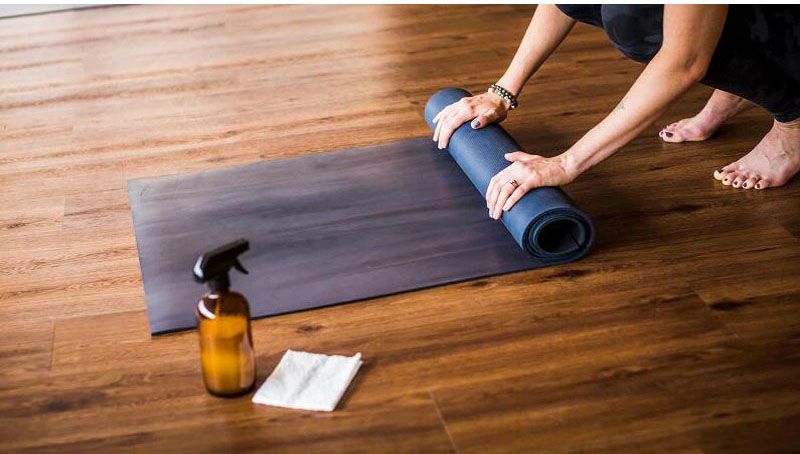
Regular cleaning: It is recommended to wash the yoga mat once a week, or according to the usage. If the yoga mat is used frequently, it is recommended to wash it every few days.
Use warm water and soapy water: When cleaning your yoga mat, wipe the surface of the mat with warm water and soapy water to thoroughly remove dirt and sweat. Be careful not to use water that is too hot, or it may damage the yoga mat.
Avoid chemical cleaners: Avoid cleaning your yoga mat with chemical cleaners, as these may damage the mat's material and non-slip properties.
Air dry in the shade: After washing, hang the yoga mat in a ventilated place out of direct sunlight to avoid deformation and fading of the material.
Regular replacement: The life of the yoga mat is about 1 to 2 years. If the yoga mat is found to be worn or deformed, it should be replaced in time.
In short, proper maintenance and cleaning can keep the yoga mat clean and in good condition, allowing you to have a better yoga practice experience.
Tips For Increasing The Slip Resistance of Yoga Mats
Maintaining the slip resistance of yoga mat is essential for yoga practitioners. Here are a few simple tips to improve the slip resistance of your yoga mat:
Clean your yoga mat regularly: Sweat, dander, and other substances can build up on your yoga mat, reducing its slip resistance. Cleaning it regularly will help keep it in good condition.
Make sure your yoga mat is placed flat: When practicing yoga, A smooth surface is the best for your yoga mat. Avoid uneven or cracked ground as it can lessen the slip resistance of your mat.
Use a yoga towel: If you sweat easily, place a yoga towel on top of your yoga mat for extra slip resistance and help prevent slipping, this will absorb sweat and prevent it from soaking into the mat.
Use yoga gloves and socks: If your hands and feet tend to sweat, consider using yoga gloves and socks. These accessories can provide better slip resistance and allow you to practice yoga more comfortably.
Note:
If you have just purchased a new yoga mat, it may be slippery until you break it in. To do this, use your mat several times a week and it will become less slippery as time passes. Breaking in your mat is essential to ensure you can practice yoga safely.
In short, the correct use of yoga mats to improve the anti-slip performance can allow you to practice yoga better and improve the safety and effectiveness of the practice.
Conclusion of Yoga Mat Purchase Guide
In conclusion, selecting the right yoga mat is essential to getting the most out of your yoga practice. When purchasing a yoga mat, you should choose according to your needs and the type of practice, considering factors such as material, thickness, size, color and pattern, slip resistance, and price. Whether you are a beginner or a seasoned yogi, a quality yoga mat can improve your practice and provide better comfort and support.

Additionally, don't forget to clean your mat after each use to ensure it stays in good condition. If you are looking for something more unique, you can also consider custom mats, but be aware of the production and delivery times.
All in all, I hope this yoga mat purchasing guide has helped you find the perfect mat for your yoga practice.
Who We Are & Our Services
WavarYoga is a manufacturer of yoga mats that is devoted to providing yoga enthusiasts from all over the globe with top-notch products and services. We have cutting-edge production equipment and technology, allowing us to produce yoga mats in a variety of materials, such as natural rubber, TPU, cork, PU, linen, and suede, all of which have excellent anti-slip, softness, support, and durability qualities that can meet the needs of different yoga practices and personal preferences.
We also provide customization and OEM services, so if you are looking for a yoga mat with a unique color, pattern, or shape, we can make it according to your specifications. Additionally, we are equipped to provide OEM service to other brands of yoga mats.
Our mission is to provide the best quality yoga products and services and to meet the individual requirements and market demands of yoga enthusiasts. If you need any type of yoga mat product or service, please do not hesitate to contact us and we will serve you wholeheartedly.